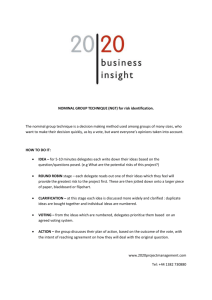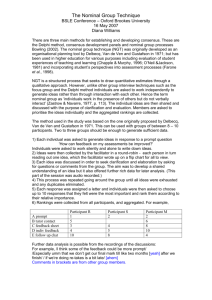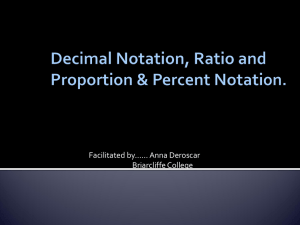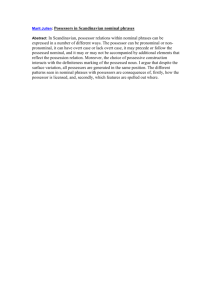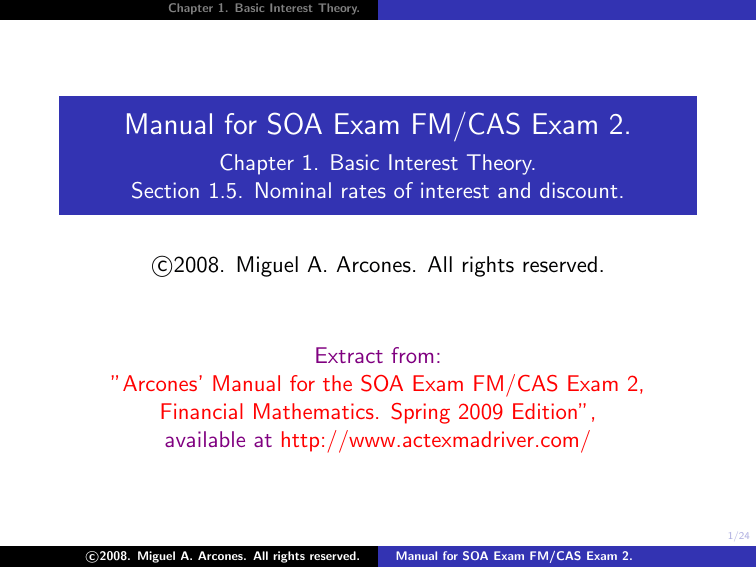
Chapter 1. Basic Interest Theory.
Manual for SOA Exam FM/CAS Exam 2.
Chapter 1. Basic Interest Theory.
Section 1.5. Nominal rates of interest and discount.
c
2008.
Miguel A. Arcones. All rights reserved.
Extract from:
”Arcones’ Manual for the SOA Exam FM/CAS Exam 2,
Financial Mathematics. Spring 2009 Edition”,
available at http://www.actexmadriver.com/
1/24
c
2008.
Miguel A. Arcones. All rights reserved.
Manual for SOA Exam FM/CAS Exam 2.
Chapter 1. Basic Interest Theory.
Section 1.5. Nominal rates of interest and discount.
Nominal rate of interest
When dealing with compound interest, often we will rates different
from the annual effective interest rate. Suppose that an account
follows compound interest with an annual nominal rate of
interest compounded m times a year of i (m) , then
I
$1 at time zero accrues to $(1 +
i (m)
m )
at time
1
m
years.
2/24
c
2008.
Miguel A. Arcones. All rights reserved.
Manual for SOA Exam FM/CAS Exam 2.
Chapter 1. Basic Interest Theory.
Section 1.5. Nominal rates of interest and discount.
Nominal rate of interest
When dealing with compound interest, often we will rates different
from the annual effective interest rate. Suppose that an account
follows compound interest with an annual nominal rate of
interest compounded m times a year of i (m) , then
i (m)
m ) at
(m)
+ i m ).
I
$1 at time zero accrues to $(1 +
I
The
1
m –year
interest factor is (1
time
1
m
years.
3/24
c
2008.
Miguel A. Arcones. All rights reserved.
Manual for SOA Exam FM/CAS Exam 2.
Chapter 1. Basic Interest Theory.
Section 1.5. Nominal rates of interest and discount.
Nominal rate of interest
When dealing with compound interest, often we will rates different
from the annual effective interest rate. Suppose that an account
follows compound interest with an annual nominal rate of
interest compounded m times a year of i (m) , then
i (m)
m ) at
(m)
+ i m ).
I
$1 at time zero accrues to $(1 +
I
The
I
The
1
m –year interest factor is (1
( m1 -year ) m–thly effective interest
time
rate is
1
m
years.
i (m)
m .
4/24
c
2008.
Miguel A. Arcones. All rights reserved.
Manual for SOA Exam FM/CAS Exam 2.
Chapter 1. Basic Interest Theory.
Section 1.5. Nominal rates of interest and discount.
Nominal rate of interest
When dealing with compound interest, often we will rates different
from the annual effective interest rate. Suppose that an account
follows compound interest with an annual nominal rate of
interest compounded m times a year of i (m) , then
I
i (m)
m ) at
(m)
+ i m ).
$1 at time zero accrues to $(1 +
time
1
m
years.
1
m –year interest factor is (1
(m)
I The ( 1 -year ) m–thly effective interest rate is i
m
m .
m
(m)
I $1 at time zero grows to $ 1 + i
in one year.
m
I
The
5/24
c
2008.
Miguel A. Arcones. All rights reserved.
Manual for SOA Exam FM/CAS Exam 2.
Chapter 1. Basic Interest Theory.
Section 1.5. Nominal rates of interest and discount.
Nominal rate of interest
When dealing with compound interest, often we will rates different
from the annual effective interest rate. Suppose that an account
follows compound interest with an annual nominal rate of
interest compounded m times a year of i (m) , then
I
i (m)
m ) at
(m)
+ i m ).
$1 at time zero accrues to $(1 +
time
1
m
years.
1
m –year interest factor is (1
(m)
I The ( 1 -year ) m–thly effective interest rate is i
m
m .
m
(m)
I $1 at time zero grows to $ 1 + i
in one year.
m
(m) mt
I $1 at time zero grows to $ 1 + i
in t years.
m
I
The
6/24
c
2008.
Miguel A. Arcones. All rights reserved.
Manual for SOA Exam FM/CAS Exam 2.
Chapter 1. Basic Interest Theory.
Section 1.5. Nominal rates of interest and discount.
Nominal rate of interest
When dealing with compound interest, often we will rates different
from the annual effective interest rate. Suppose that an account
follows compound interest with an annual nominal rate of
interest compounded m times a year of i (m) , then
i (m)
m ) at
(m)
+ i m ).
I
$1 at time zero accrues to $(1 +
I
The
I
I
I
I
time
1
m
years.
1
m –year interest factor is (1
(m)
The ( m1 -year ) m–thly effective interest rate is i m .
(m) m
$1 at time zero grows to $ 1 + i m
in one year.
(m) mt
$1 at time zero grows to $ 1 + i m
in t years.
(m) mt
.
The accumulation function is a(t) = 1 + i m
7/24
c
2008.
Miguel A. Arcones. All rights reserved.
Manual for SOA Exam FM/CAS Exam 2.
Chapter 1. Basic Interest Theory.
Section 1.5. Nominal rates of interest and discount.
Example 1
Paul takes a loan of $569. Interest in the loan is charged using
compound interest. One month after a loan is taken the balance in
this loan is $581.
(i) Find the monthly effective interest rate, which Paul is charged
in his loan.
(ii) Find the annual nominal interest rate compounded monthly,
which Paul is charged in his loan.
8/24
c
2008.
Miguel A. Arcones. All rights reserved.
Manual for SOA Exam FM/CAS Exam 2.
Chapter 1. Basic Interest Theory.
Section 1.5. Nominal rates of interest and discount.
Example 1
Paul takes a loan of $569. Interest in the loan is charged using
compound interest. One month after a loan is taken the balance in
this loan is $581.
(i) Find the monthly effective interest rate, which Paul is charged
in his loan.
(ii) Find the annual nominal interest rate compounded monthly,
which Paul is charged in his loan.
Solution: (i) The monthly effective interest rate, which Paul is
charged in his loan is
i (12)
581 − 569
=
= 2.108963093%.
12
569
9/24
c
2008.
Miguel A. Arcones. All rights reserved.
Manual for SOA Exam FM/CAS Exam 2.
Chapter 1. Basic Interest Theory.
Section 1.5. Nominal rates of interest and discount.
Example 1
Paul takes a loan of $569. Interest in the loan is charged using
compound interest. One month after a loan is taken the balance in
this loan is $581.
(i) Find the monthly effective interest rate, which Paul is charged
in his loan.
(ii) Find the annual nominal interest rate compounded monthly,
which Paul is charged in his loan.
Solution: (i) The monthly effective interest rate, which Paul is
charged in his loan is
i (12)
581 − 569
=
= 2.108963093%.
12
569
(ii) The annual nominal interest rate compounded monthly, which
Paul is charged in his loan is
i (12) = (12)(0.02108963093) = 25.30755712%.
10/24
c
2008.
Miguel A. Arcones. All rights reserved.
Manual for SOA Exam FM/CAS Exam 2.
Chapter 1. Basic Interest Theory.
Section 1.5. Nominal rates of interest and discount.
Two rates of interest or discount are said to be equivalent if they
give rise to same accumulation function. Since, the accumulation
function under an annual effective rate of interest i is
a(t) = (1 + i)t , we have that a nominal annual rate of interest i (m)
compounded m times a year is equivalent to an annual effective
rate of interest i, if the rates
!mt
i (m)
a(t) = 1 +
m
and
a(t) = (1 + i)t
agree. This happens if and only if
!m
i (m)
1+
= 1 + i.
m
11/24
c
2008.
Miguel A. Arcones. All rights reserved.
Manual for SOA Exam FM/CAS Exam 2.
Chapter 1. Basic Interest Theory.
Section 1.5. Nominal rates of interest and discount.
Example 1
John takes a loan of 8,000 at a nominal annual rate of interest of
10% per year convertible quarterly. How much does he owe after
30 months?
12/24
c
2008.
Miguel A. Arcones. All rights reserved.
Manual for SOA Exam FM/CAS Exam 2.
Chapter 1. Basic Interest Theory.
Section 1.5. Nominal rates of interest and discount.
Example 1
John takes a loan of 8,000 at a nominal annual rate of interest of
10% per year convertible quarterly. How much does he owe after
30 months?
Solution: We find
0.10
8000 1 +
4
30 ·4
12
= 8000 (1 + 0.025)10 = 10240.68.
In the calculator, we do:
8000 PV 2.5 I/Y 10 N CPT FV .
13/24
c
2008.
Miguel A. Arcones. All rights reserved.
Manual for SOA Exam FM/CAS Exam 2.
Chapter 1. Basic Interest Theory.
Section 1.5. Nominal rates of interest and discount.
The calculator TI–BA–II–Plus has a worksheet to convert nominal
rates of interest into effective rates of interest and vice versa. To
enter this worksheet press 2nd ICONV . There are 3 entries in
this worksheet: NOM , EFF and C/Y . C/Y is the number of
times the nominal interest is converted in a year. The relation
between these variables is
C/Y
EFF
NOM
= 1 +
1+
.
100
100 C/Y
You can enter a value in any of these entries by moving to that
entry using the arrows: ↑ and ↓ . To enter a value in one entry,
type the value and press ENTER . You can compute the
corresponding nominal (effective) rate by moving to the entry
NOM ( EFF ) and pressing the key CPT . It is possible to enter
negative values in the entries NOM and EFF . However, the
value in the entry C/Y has to be positive.
14/24
c
2008.
Miguel A. Arcones. All rights reserved.
Manual for SOA Exam FM/CAS Exam 2.
Chapter 1. Basic Interest Theory.
Section 1.5. Nominal rates of interest and discount.
Example 2
If i (4) = 5% find the equivalent effective annual rate of interest.
15/24
c
2008.
Miguel A. Arcones. All rights reserved.
Manual for SOA Exam FM/CAS Exam 2.
Chapter 1. Basic Interest Theory.
Section 1.5. Nominal rates of interest and discount.
Example 2
If i (4) = 5% find the equivalent effective annual rate of interest.
4
Solution: We solve 1 + i = 1 + 0.05
and get i = 5.0945%. In
4
the calculator, you enter the worksheet ICONV and enter: NOM
equal to 5 and C/Y equal to 4. Then, go to EFF and press
CPT . To quit, press 2nd , QUIT .
16/24
c
2008.
Miguel A. Arcones. All rights reserved.
Manual for SOA Exam FM/CAS Exam 2.
Chapter 1. Basic Interest Theory.
Section 1.5. Nominal rates of interest and discount.
Example 3
If i = 5%, what is the equivalent i (4) ?
17/24
c
2008.
Miguel A. Arcones. All rights reserved.
Manual for SOA Exam FM/CAS Exam 2.
Chapter 1. Basic Interest Theory.
Section 1.5. Nominal rates of interest and discount.
Example 3
If i = 5%, what is the equivalent i (4) ?
(4) 4
Solution: We solve 1 + i 4
= 1 + 0.05 we get that
(4)
1/4
i = 4 (1 + 0.05) − 1 = 4.9089%. In the calculator, you
enter the worksheet ICONV and enter: EFF equal to 5 and
C/Y equal to 4. Then, go to NOM and press CPT . To quit,
press 2nd , QUIT .
18/24
c
2008.
Miguel A. Arcones. All rights reserved.
Manual for SOA Exam FM/CAS Exam 2.
Chapter 1. Basic Interest Theory.
Section 1.5. Nominal rates of interest and discount.
d (m)
The nominal rate of discount
is defined as the value such
(m)
that 1 unit at the present is equivalent to 1 − dm units invested m1
years ago, i.e.
1
d (m)
units at time 0} ≡ 1 unit at time
.
{1 −
m
m
This implies that
(
{1 unit at time 0} ≡
1
1−
d (m)
m
1
units at time
m
)
.
The accumulation function for compound interest under a the
nominalrate of discount
d (m) convertible m times a year is
a(t) = 1 −
d (m)
m
1+i =
−mt
. We have that
i (m)
1+
m
!m
−1
= (1 − d)
=
d (m)
1−
m
!−m
.
19/24
c
2008.
Miguel A. Arcones. All rights reserved.
Manual for SOA Exam FM/CAS Exam 2.
Chapter 1. Basic Interest Theory.
Section 1.5. Nominal rates of interest and discount.
In the calculator TI–BA–II–Plus, you may:
I
given i (m) , find i, by entering
i (m) → NOM and m → C/Y , then in EFF press CPT .
I
given i, find i (m) , by entering
i → EFF and m → C/Y , then in NOM press CPT .
I
given d (m) , find d, by entering
−d (m) → NOM and m → C/Y , then in EFF press CPT .
d appears with a negative sign.
I
given d, find d (m) , by entering
−d → EFF and m → C/Y , then in NOM press CPT .
d (m) appears with a negative sign.
1
1−d
I
given i, find d, by using the formula i =
I
given d, find i, by using the formula d = 1 −
− 1.
1
1+i .
20/24
c
2008.
Miguel A. Arcones. All rights reserved.
Manual for SOA Exam FM/CAS Exam 2.
Chapter 1. Basic Interest Theory.
Section 1.5. Nominal rates of interest and discount.
Example 4
If d (4) = 5% find i.
21/24
c
2008.
Miguel A. Arcones. All rights reserved.
Manual for SOA Exam FM/CAS Exam 2.
Chapter 1. Basic Interest Theory.
Section 1.5. Nominal rates of interest and discount.
Example 4
If d (4) = 5% find i.
Solution: We solve 1 −
d (4)
4
−4
= 1 + i to get d = 4.9070% and
i = 5.1602%. In the calculator, in the ICONV worksheet, we
enter −5 in NOM , 4 in C/Y and we find that EFF is
−4.9070%, then we do
−4.9070 % + 1 = 1/x − 1 =
to get i = 5.1602%.
22/24
c
2008.
Miguel A. Arcones. All rights reserved.
Manual for SOA Exam FM/CAS Exam 2.
Chapter 1. Basic Interest Theory.
Section 1.5. Nominal rates of interest and discount.
Example 5
If i = 3% find d (2) .
23/24
c
2008.
Miguel A. Arcones. All rights reserved.
Manual for SOA Exam FM/CAS Exam 2.
Chapter 1. Basic Interest Theory.
Section 1.5. Nominal rates of interest and discount.
Example 5
If i = 3% find d (2) .
(2) −2
Solution: We solve for d (2) in 1 − d 2
= 1 + i. First we find
that d = 2.9126% doing
3 % + 1 = 1/x − 1 =
Then, using the ICONV worksheet, we get that d (2) = 2.9341%.
24/24
c
2008.
Miguel A. Arcones. All rights reserved.
Manual for SOA Exam FM/CAS Exam 2.



